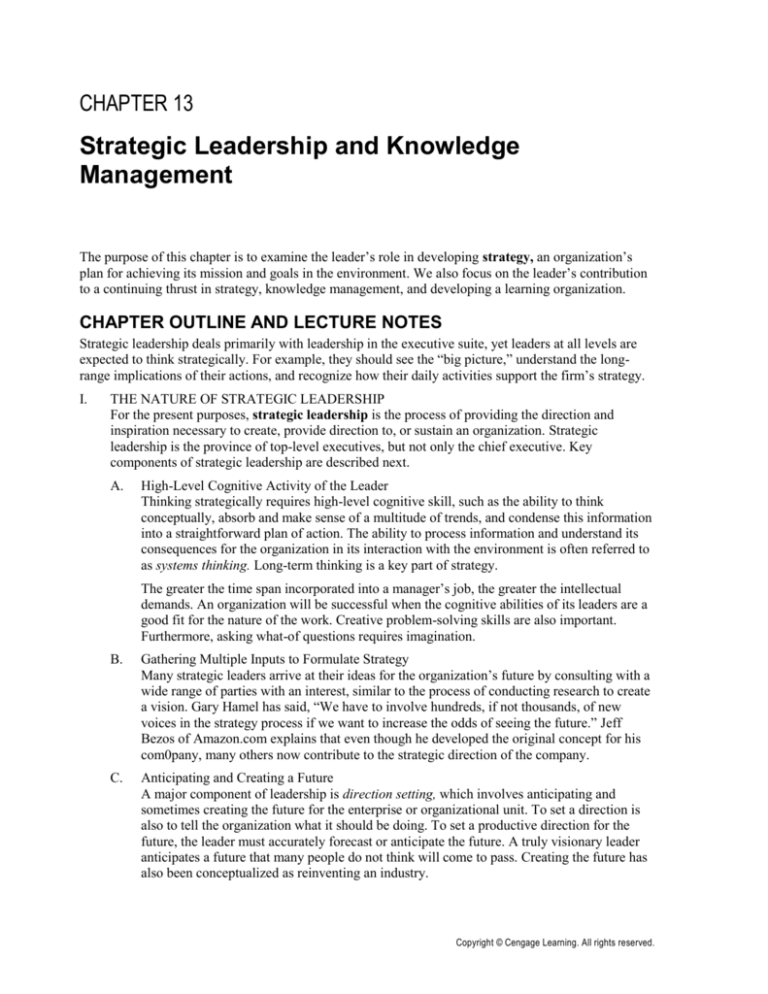
CHAPTER 13
Strategic Leadership and Knowledge
Management
The purpose of this chapter is to examine the leader’s role in developing strategy, an organization’s
plan for achieving its mission and goals in the environment. We also focus on the leader’s contribution
to a continuing thrust in strategy, knowledge management, and developing a learning organization.
CHAPTER OUTLINE AND LECTURE NOTES
Strategic leadership deals primarily with leadership in the executive suite, yet leaders at all levels are
expected to think strategically. For example, they should see the “big picture,” understand the longrange implications of their actions, and recognize how their daily activities support the firm’s strategy.
I.
THE NATURE OF STRATEGIC LEADERSHIP
For the present purposes, strategic leadership is the process of providing the direction and
inspiration necessary to create, provide direction to, or sustain an organization. Strategic
leadership is the province of top-level executives, but not only the chief executive. Key
components of strategic leadership are described next.
A.
High-Level Cognitive Activity of the Leader
Thinking strategically requires high-level cognitive skill, such as the ability to think
conceptually, absorb and make sense of a multitude of trends, and condense this information
into a straightforward plan of action. The ability to process information and understand its
consequences for the organization in its interaction with the environment is often referred to
as systems thinking. Long-term thinking is a key part of strategy.
The greater the time span incorporated into a manager’s job, the greater the intellectual
demands. An organization will be successful when the cognitive abilities of its leaders are a
good fit for the nature of the work. Creative problem-solving skills are also important.
Furthermore, asking what-of questions requires imagination.
B.
Gathering Multiple Inputs to Formulate Strategy
Many strategic leaders arrive at their ideas for the organization’s future by consulting with a
wide range of parties with an interest, similar to the process of conducting research to create
a vision. Gary Hamel has said, “We have to involve hundreds, if not thousands, of new
voices in the strategy process if we want to increase the odds of seeing the future.” Jeff
Bezos of Amazon.com explains that even though he developed the original concept for his
com0pany, many others now contribute to the strategic direction of the company.
C.
Anticipating and Creating a Future
A major component of leadership is direction setting, which involves anticipating and
sometimes creating the future for the enterprise or organizational unit. To set a direction is
also to tell the organization what it should be doing. To set a productive direction for the
future, the leader must accurately forecast or anticipate the future. A truly visionary leader
anticipates a future that many people do not think will come to pass. Creating the future has
also been conceptualized as reinventing an industry.
Copyright © Cengage Learning. All rights reserved.
Chapter 13: Strategic Leadership and Knowledge Management
D.
101
Revolutionary and Contrarian Thinking
Hamel characterizes strategy as revolutionary. Incrementalism is not sufficient. To be an
industry leader, a company’s leaders must think in revolutionary terms. Any strategy that
does not challenge the status quo should not even be considered a strategy. Before an
organization can re-invent itself, it may be necessary to admit that a strategy successful in
the past no longer fits the times. For strategic leadership to be revolutionary, it would have
to redefine products and services, market space, and even the entire industry. Porter insists
that a key component of strategy is choosing to be different. Nevertheless, the strategy of
imitation has served many firms well.
A variation of choosing to be different is to engage in contrarian thinking in which the leader
rejects conventional wisdom, much like the investor who trolls for hidden value in out-offavor stocks.
E.
II.
Creating a Vision
Visions are an integral part of strategic leadership. The final vision statement is relatively
short. A carefully considered and articulated vision helps us know who we are and who we
are not. Articulating a clear vision helped get several great companies off the ground when
the company founders were seeking funding from venture capitalists, with Google being a
good example. In companies that believe strongly in visions and strategic goals, all activities
throughout the company are supposed to support the vision and goals.
CONDUCTING A SWOT ANALYSIS
Strategic planning encompasses those activities that lead to the statement of goals and objectives
and the choice of strategy. Strategic planning often takes the form of a SWOT analysis, a method
of considering internal strengths and weaknesses, and external opportunities and threats in a given
situation. A SWOT analysis examines the interaction between the organization, or organizational
unit, and the environment.
A.
Internal Strengths
Assess factors within the organization that will have a positive impact on implementing the
plan. What are your advantages and what do you do well?
B.
Internal Weaknesses
Take a candid look at factors within the firm that could have a negative impact on the
proposed plan. Consider the risks of pursuing a particular course of action.
C.
External Opportunities
Assess socioeconomic, political, environmental, and demographic factors in terms of
benefits they may bring to the organization. Think of the opportunities that welcome you if
you choose a promising strategic alternative.
D.
External Threats
Assess the possible negative impact socioeconomic, political, environmental, and
demographic factors may have on the organization. There’s a downside to every alternative,
so think ahead to allow for contingency planning. For example, is changing technology
changing your ability to compete successfully?
III. A SAMPLING OF BUSINESS STRATEGIES FORMULATED BY LEADERS
In addition to the process of making strategic decisions, the content of these decisions is
important. Business strategies are often classified according to their focus of impact: corporate
level, business level, or functional level. Thirteen current strategies are described next.
A.
Differentiation. A differentiation strategy attempts to offer a product or service that is
perceived by the customer as different from available alternatives.
Copyright © Cengage Learning. All rights reserved.
102
Chapter 13: Strategic Leadership and Knowledge Management
B.
C.
D.
E.
F.
G.
H.
I.
J.
K.
L.
M.
N.
Cost leadership. A cost leadership strategy is to produce a product or service at a low price
to lower price and gain market share.
Focus or niche. Using a focus strategy, the organization concentrates on a specific regional
market or buyer group. The extended-stay hotel concept is one of many on-target business
examples. An amusing example here would be a company whose sole product is stampcollection albums because of the narrowly defined market.
High quality. Leaders continue to emphasize quality even if there is less explicit emphasis
today on formal quality programs. An important exception is the Six Sigma programs that
emphasize statistical approaches to attaining quality.
Imitation. Using the imitation strategy, the company waits for the right time to introduce a
lower-priced competitor. Benchmarking is a form of learning by watching.
Strategic alliances. An increasingly popular business strategy is to form alliances, or share
resources, with other companies to exploit a market opportunity. A strategic alliance is also
known as a virtual corporation. Marketing partnerships are another form of strategic
alliance.
Growth through acquisition. A standard strategy for growth is for one company to purchase
others. However, acquisitions are often made to acquire an important technology.
High speed and first-mover. High-speed managers focus on speed in all of their business
activities, including production development, sales response, and customer service. Getting
to market first is also referred to as the first-mover strategy. Moving in after a product or
service is already successful will sometimes best the first-mover strategy.
Product and global diversification. A natural business strategy is to offer a variety of
products and services, and to sell across borders to enhance market opportunities.
Sometimes a company with a strong reputation for delivering one product or service will
branch out to capitalize on the allure of its brand.
Sticking to core competencies. Many firms of all sizes believe that they will prosper if they
confine their efforts to the activities they perform best—their core competencies.
Jim Collins calls this the Hedgehog concept.
Brand leadership. Succeeding through developing the reputation of your brand can be
considered a business strategy. Many Internet-based companies perceive brand leadership as
a key to their survival. The five strongest brands are Coca-Cola, Microsoft, IBM, GE, and
Nokia.
Create demand by solving problems. The simple idea that the best way to sell is to offer to
solve a problem has become a business strategy. You find where the problems are then offer
a product or serviced to solve that problem.
Competitive advantage through hiring talented people. To build great companies the most
urgent business charge is to find and keep great people. Talented people may need some
leadership, but they will think of new products and services and develop effective work
processes.
All of the impressive strategies just described have limited impact unless they are
implemented properly, meaning that effective management must support strategic
leadership. Strategies are sometimes not implemented correctly because top management is
not aware of problems that threaten the business.
IV. KNOWLEDGE MANAGEMENT AND THE LEARNING ORGANIZATION
Another strategic thrust of leaders is to help their organizations better adapt to the environment by
assisting workers and the organization to become better learners. Knowledge management (KM)
is a concerted effort to improve how knowledge is created, delivered, and applied. Sharing of
information is a key aspect of knowledge information. Managing knowledge well helps an
organization learn. A learning organization is one that is skilled at creating, acquiring, and
transferring knowledge, and at modifying behavior to reflect new knowledge and insights.
Copyright © Cengage Learning. All rights reserved.
Chapter 13: Strategic Leadership and Knowledge Management
A.
103
Knowledge Management
Managing knowledge is an important leadership role because so few organizations make
systematic use of the collective wisdom of employees. As illustrated in Figure 13–2, most
knowledge in the organization resides in the brains of employees or in documents not readily
accessible to others. Knowledge management has three components. Knowledge creation is
used to spur innovation. Knowledge dissemination through information technology is the
most frequent activity within knowledge management. Knowledge application is the process
of getting workers better at what they do.
1.
General Format of KM Programs. A study of 800 managers found that 78 percent
share information through personal and informal channels, compared to 19 percent that
have technology-driven systems. Story telling can be helpful in knowledge sharing.
A recent advance in knowledge management is to deliver information just in time, or at
the point when it is most needed. The idea is to “bake” specialized knowledge into the
jobs of workers with advanced skills, such as Partners HealthCare has done.
Advanced technology for knowledge management must be combined with a culture
that values knowledge and encourages its dissemination. The organization subculture
shapes our assumptions about what constitutes knowledge, and which knowledge is
worth managing.
2.
B.
Potential Pitfalls of KM Programs. A major challenge is the human tendency to want
to keep our best ideas secret, so we can receive full credit for them. Face-to-face
communication remains critical to knowledge management, particularly for sparking
new insights. Knowledge management programs often get off to a good start, and then
fizzle. For example, the first KM team might squeeze out all the useful knowledge.
The Learning Organization
According to Peter Senge, a learning organization can be looked upon simply as a group of
people working together to enhance their capacities to create results they value. To help
create a learning organization, about 100 large firms have created a position such as Chief
Knowledge Officer.
A leader can help create a learning organization in many ways. First, the leader should
create a strategic intent to learn thereby gaining competitive advantage. Creating a shared
vision is important. Systems thinking is almost synonymous with organizational learning,
whereby people see the interrelatedness of their work. Personal mastery of the job should be
encouraged, as well as team learning that centers on collective problem solving.
Action learning, or learning while working on real problems, is a fundamental part of a
learning organization. Participants in action learning are asked to work in teams to attack a
significant organizational problem. Learning from failure contributes to organizational
learning, and so does encouraging continuous experimentation. Finally, the leader must
encourage workers to think creatively.
V.
GUIDELINES FOR ACTION AND SKILL DEVELOPMENT
To ensure that all workers understand the company’s vision of where it wants to go, the vision
statement should be (a) brief, (b) verifiable, (c) focused on a major goal, (d) understandable, and
(e) inspirational.
Copyright © Cengage Learning. All rights reserved.
104
Chapter 13: Strategic Leadership and Knowledge Management
COMMENTS ON EXPERIENTIAL EXERCISES
Leadership Self-Assessment Quiz 13-1: Are You a Strategic Thinker?
If taken with a spirit of self-objectivity, this questionnaire can help many students realize that a key area
for growth is the ability to “think big.” In general, people tend to think less strategically early in their
careers.
Leadership Skill-Building Exercise 13-1: Conducting a SWOT
Analysis
Conducting a SWOT analysis is a tangible leadership and management skill that most students enrolled
in a business leadership class would enjoy. Students with an interest in the public sector or the nonprofit
sector should also find a SWOT analysis to be valuable. Most students are probably familiar with
SWOT analysis so this exercise should give them a chance to practice their skills.
Leadership Self-Assessment Quiz 13-2: Do You Work for a Learning
Organization?
It would be a stretch for most students to have knowledgeable responses to most of these statements.
However, mulling over the characteristics of a learning organization may help provide new insights.
Leadership Self-Assessment Quiz 13-3: My Attiudes Toward Sharing
Knowledge
Sharing knowledge is critical to the success of knowledge management, yet many people would prefer
to keep their best ideas to themselves. This quiz helps the student reflect on how willing he or she might
be to share knowledge in a competitive environment.
COMMENTS ON DISCUSSION QUESTIONS AND ACTIVITIES
1.
How might a business strategy deal with a topic other than products or services?
Although we usually think of strategy in relation to products or services, strategies can also be
developed about processes. A major success strategy for Dell, for example, has been to attain
world-class efficiencies including tight control over costs. Many companies today have strategies
about demographic and cultural diversity, such as hoping to attain success by having a workforce
that matches the demographic characteristics of the customer base.
2.
In what way can a business strategy motivate and inspire employees?
A business strategy can be motivational because the right strategy can be inspirational,
particularly if the strategy points the organization in a bold, new direction. For example, it might
be inspiring to know that the company is embarking on a bold acquisition strategy that will make
it a dominant player in the field. Under the leadership of Andrea Jung, Avon Products is
expanding to have a bigger presence on the Web and in malls, and by offering a wider line of
products. Many Avon ladies are inspired to work harder, as they are part of a greater enterprise.
3.
How could you adapt a business strategy to guide you in your own career as a leader?
Several business strategies can be applied personally to guide a person’s leadership career. How
about differentiation to gain an edge on the competition—like knowing enterprise software and
speaking Russian? Sticking to core competencies is another winner for the leader who wants to
build on strengths.
Copyright © Cengage Learning. All rights reserved.
Chapter 13: Strategic Leadership and Knowledge Management
4.
105
Many top-level managers say that they want lower-ranking managers to think strategically. How
can a middle manager or a first-level manager “think strategically”?
Middle managers can think strategically by looking at the long-range implications of their
thinking, investigating how their activities interact with the outside environment, and attempting
to ensure that their daily activities support corporate strategy.
5.
Why might finding a niche for the organization be the most important activity of a strategic
leader?
Finding a niche for an organization is often the most important activity for a strategic leader,
particularly when the organization is launched. Without a niche, an organization has no focus or
purpose. Many restaurants fail to get off the ground because it is not apparent that the restaurant
offers anything different from its many competitors. A niche can also be quite broad, such as
founding a small conglomerate.
6.
Working alone or with several team members, provide a recent example of revolutionary thinking
by a company.
For an idea dreamed up by company management to qualify as revolutionary thinking, it must go
beyond a product or service that already exists. The palm-size, wireless computers that access the
Internet might be considered revolutionary because the owner does not have to be at a fixed, wired
location to gain Internet access. The Netflix business model of ordering rental DVDs on line is
perceived by many to be revolutionary. The DVD fan could then order films without having to
visit a physical store. The effectiveness of the Netflix model spawned major companies like
Amazon.com and Blockbuster to follow suit quickly.
7.
The average age of Cadillac owners, across the various models, was about 63 until the Escalade (a
luxury SUV) was introduced into the market. The Cadillac Escalade had an immediate appeal to
affluent rappers, professional athletes, and a variety of other young, wealthy entertainers. What is
the business strategy lesson here?
The answer to this question is worth at least a Harvard Business School case. Cadillac had drifted
into an unintended focus strategy, with customers clustered in one age bracket. We say clustered,
because Cadillac always had some affluent, young buyers. The marketing people struggled to find
a product that would appeal to a larger number of young people and they were successful. In
addition, a little serendipity boosted their efforts. The Escalade also caught on with wealthy, hip
people and created a loud buzz.
8.
In what way might doing a good job of knowledge management give a company a competitive
advantage?
A company that manages knowledge well would gain a competitive advantage through such
means as solving internal problems better, solving customer problems better, and, in general,
having a continuing stream of useful ideas.
9.
Why is it that even IT professionals believe that the interpersonal aspects of knowledge sharing
are more important than the software systems for collecting and sharing ideas?
The view that the interpersonal aspects of knowledge sharing is more important than sharing
through technology is probably based on first-hand experiences, going back to times at high
school and college. Information technology specialists are accustomed to enhancing their wisdom
through batting around ideas with each other. On the job also, technical people are accustomed to
chatting about ideas in order to enhance creative thinking.
Copyright © Cengage Learning. All rights reserved.
106
Chapter 13: Strategic Leadership and Knowledge Management
10. Why do you think it has been so difficult for researchers to prove that knowledge management
really pays dividends to an organization?
A primary problem is that it is difficult to know when knowledge management has taken place.
Suppose company leadership mandates that people talk more freely with each other to share ideas,
and encourages them to use the company Intranet for ideas. It is difficult to catalogue whether
such activities have actually taken place. Another problem is one of experimental design. If a
company implements a program of knowledge management and profits improve—or decline—it
is difficult to know whether KM or other factors might have been responsible for the changes in
profits. The company might implement knowledge management in one business unit and use
another business unit as a control, and then make comparisons. However, such experimentation is
rate in business.
PLAUSIBLE RESPONSES TO CASE QUESTIONS
Leadership Case Problem A: Samsung Sings a Different Tune
We have updated this case slightly from the previous edition because students enjoy analyzing
Samsung and Kim. A key theme of the Samsung case is that company leadership can successfully
change the strategy of an established firm, thereby bringing it to a new level of success.
1.
Identify at least three business (or marketing) strategies Samsung uses now or used in the past.
Samsung established itself with a cost leadership strategy, pricing its goods at the low end of the
consumer electronics market. Later Samsung Electronics focused on a brand leadership strategy,
as it developed the reputation of its brand. Being a components supplier for other companies is
also a strategy, and helps form strategic alliances.
2.
What suggestions can you offer Kim Samsung leaders so they can become even more successful
in building the Samsung brand?
The methods the company has chosen to build the Samsung brand are working so far. It would
therefore be advisable to continue with this strategy, and market even more heavily. Perhaps
hiring a name athlete to help promote the brand would be useful, as would having Samsung
products placed in movies. Samsung’s success in the high-end television receivers has
strengthened the brand even more.
3.
What is your opinion of Eric Kim as a strategic leader? Explain your answer.
The evidence so far indicates that Kim is a highly effective strategic leader. He identified a major
potential problem for Samsung—that its products would become vulnerable to other companies
that could produce the same goods at an even lower price. Kim’s solution was to point the
company in a new direction that is working so far. The fact that in 2004, Kim became the General
Manager of the Digital Home Group at Intel suggests that he is a valuable strategic leader.
4.
How realistic is Samsung’s vision of become the leader in the digital convergence revolution?
Samsung is poised to become a leader in the digital convergence revolution because of their
strong presence in high-end consumer electronics including flat-screen television receivers. Being
a South Korean company further enhances Samsung’s reputation as a company with excellent
technology.
Copyright © Cengage Learning. All rights reserved.
Chapter 13: Strategic Leadership and Knowledge Management
107
Leadership Case Problem B: IHOP Wants to Rejuvenate Applebee’s
This case illustrates some of the challenges managers face when they attempt to be successful in a basic
industry such as food service.
1.
What strategic suggestions might you offer Stewart and the IHOP executive team to improve the
performance of the Applebee’s division?
As hinted in the case material presented, Stewart and her team need to further differentiate
Applebee’s from the competition. However, Applebee’s is still a strong brand so the strategy
should build on the brand rather than changing it so much that the equity in the Applebee’s brand
diminishes considerable.
2.
To what extent are Nicklin’s suggestions strategic?
Portfolio manager Nicklin might have the right answer for Applebee’s in terms of improving the
food offerings and the look of the restaurants. However, the suggestions have to with incremental
improvements rather than a new strategic direction.
3.
How about visiting an Applebee’s restaurant to make some observations about what the chain can
do to become competitive and profitable? As an alternative, interview a few people in your
network who have dine or worked at an Applebee’s recently.
Although most people have strong opinions about what it takes for a restaurant to succeed, it
would require a high level of marketing strategy to change the Applebee’s concept into something
else that would be equally or more successful. Some people might suggest that Applebee’s
undergo a complete makeover and imitate the Cheesecake Factory chain or some other currently
hot restaurant. However, completely changing Applebee’s is probably represents too great a risk.
Applebee’s has been successful, whereas many other new chains have failed miserably. People
such as the students in this course should prove to be a useful source of input for strategy
formulation at Applebee’s.
Copyright © Cengage Learning. All rights reserved.











